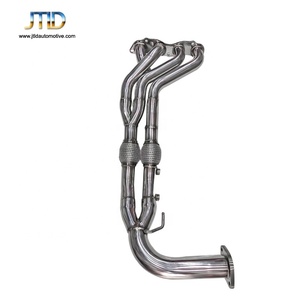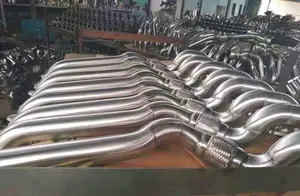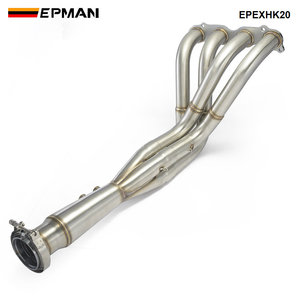(120 products available)

















































































































































There are several types of K20 headers, each designed to improve exhaust flow and enhance engine performance in unique ways. Here are some common ones:
Long Tube Headers:
K20 long tube headers are designed with elongated primary tubes that merge into a larger collector. This design maximizes exhaust gas velocity and minimizes backpressure, resulting in improved engine performance, especially at higher RPMs. They are a popular choice for racing and performance-oriented K20 engines.
Shorty Headers:
K20 shorty headers feature shorter primary tubes and typically bolt directly to the factory exhaust manifold. While they may not provide the same level of performance gains as long tube headers, they offer improved exhaust flow compared to stock manifolds. Shorty headers are often preferred for applications where emissions compliance and ease of installation are essential.
Tri-Y Headers:
K20 tri-Y headers are characterized by their unique primary tube arrangement. The headers feature three primary tubes that merge into two Y-shaped collectors. This design optimizes exhaust scavenging and enhances low-end torque, making them suitable for applications requiring strong mid-range performance.
Stainless Steel vs. Mild Steel Headers:
K20 headers can be constructed from stainless steel or mild steel. Stainless steel headers offer excellent corrosion resistance and durability, making them suitable for high-performance street use. On the other hand, mild steel headers are more cost-effective but may require coating or plating to prevent rust and corrosion.
Before buying K20 headers, retailers need to know about their specifications and how to maintain them so that they can pass the information on to their customers. Below are the specifications and maintenance tips.
Specification
Below are some of the specifications of K20 headers.
- Material: K20 headers are made with different kinds of materials. The most common one is steel. Steel headers are durable and resistant to damage. They also don't rust or corrode when exposed to moisture. Other materials used are stainless steel and cast iron. Stainless steel headers have a high resistance to rust and are also extremely durable. They can, however, be expensive. On the other hand, cast iron headers are a bit affordable and have good durability. Nonetheless, they are heavy and take time to heat up or cool down.
- Design: The K20 header design varies depending on the choice of vehicle and the model. The most common ones are long tube and short tube headers. Long tube headers have longer primary pipes that offer a smooth flow of exhaust gases, which in turn improves the performance of the vehicle. They are suitable for racing cars. Short tube headers, on the other hand, have shorter primary pipes. They heat up quickly and are mostly used in street cars. Another design of K20 headers is the equal-length headers. The primary pipes of equal-length headers have the same length, which improves engine performance. However, they are expensive and require a lot of time to make.
Maintenance
- Regular Inspection: Check the k20 headers regularly for any signs of damage or wear and tear, such as cracks and rust. This makes it easier to know what is wrong with the headers so that they can be repaired or replaced.
- Cleaning: Clean the K20 headers using a soft cloth or brush regularly. This removes any dirt or debris that may affect their performance. Also, use a mild cleaner or degreaser when cleaning, as harsh chemicals can damage the headers.
- Proper Installation: Ensure that the K20 headers are installed correctly according to the manufacturer's instructions. Improper installation can cause leaks or damage to the headers.
- Heat Management: The headers can get extremely hot when the vehicle is in use. Therefore, avoid touching or coming into contact with them directly. Use heat-resistant gloves or tools when handling the headers.
Before choosing a K20 header, it's important to understand the needs and preferences of the target market. The following are some key considerations when choosing a K20 header.
The header material affects the durability and performance of the K20 header. Stainless steel headers are strong and resistant to corrosion, while mild steel headers are more affordable but may rust over time. Cast iron headers offer good heat resistance but are heavier than other materials. Aluminium headers are lightweight but not as heat resistant as other options. Consider the material's advantages and disadvantages based on expected use.
Different K20 headers have distinct designs that influence engine performance in various ways. Some common designs include tubular headers, cast iron manifold headers, and tri-y headers. Tubular headers have smooth, rounded tubes that minimize exhaust flow restrictions and improve engine efficiency. They are suitable for high-performance applications but may require more fitting work. Cast iron manifold headers are heavy but affordable and suitable for everyday driving. Tri-Y headers combine two tubes into a Y shape before connecting to the collector. This design optimizes scavenging and enhances low-end torque.
When selecting a K20 header, consider the size of the exhaust pipes and the flange that connects to the exhaust system. Ensure the header's dimensions match the exhaust system's compatibility for optimal performance. A well-fitting header improves exhaust flow and reduces vibrations.
The finish and coating of K20 headers can affect their appearance and performance. Some headers have polished or chrome finishes for a stylish look, while ceramic coatings offer heat resistance and durability. Consider the header finish based on aesthetic preferences and expected wear and tear.
Furthermore, Budget constraints also influence the choice of a K20 header. Headers made from high-quality materials and advanced manufacturing techniques tend to be more expensive. Consider the long-term benefits of improved engine performance and fuel efficiency when choosing a header within the budget.
Replacing a K20 header is a straightforward process that can be done with basic hand tools. Here are the steps to replace a K20 header:
1. Gather the necessary tools:
2. Prepare the vehicle:
3. Remove the old header:
4. Install the new header:
5. Final steps:
Q1: What is the K20 header?
A1: The K20 header is a type of exhaust header designed to improve the performance of Honda's K20 engines. It replaces the stock exhaust manifold and is used in many performance-oriented applications, including street racing, drag racing, and track racing.
Q2: What are the benefits of using the K20 header?
The K20 header offers several advantages over the stock exhaust manifold. By increasing exhaust flow, it enhances engine performance and provides a noticeable power increase. Additionally, the K20 header can improve throttle response, making the engine feel more lively and responsive. The header also produces a more aggressive exhaust note, adding to the overall driving experience.
Q3: Can the K20 header be used on any K20 engine?
A3: While the K20 header is designed for Honda's K20 engines, there are variations depending on the specific model and year. It's essential to choose a header that matches the exact specifications of the K20 engine to ensure proper fitment and performance gains.
Q4: Is the K20 header legal for street use?
A4: The legality of the K20 header for street use depends on several factors, including the header's design, emissions compliance, and local regulations. Some headers are designed to be emissions-compliant and legal for street use, while others may not meet emissions standards. Before installing a K20 header, check the local laws and regulations regarding emissions compliance.
Q5: Can the K20 header be installed as a DIY project?
A5: The K20 header can be installed as a DIY project. However, header installation requires advanced mechanical skills, access to specific tools, and knowledge of automotive exhaust systems. Proper torque specifications and gasket replacement are crucial for a successful header installation. If unsure about the installation, it's recommended to have the K20 header installed by a professional mechanic.